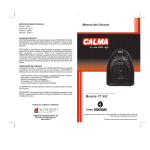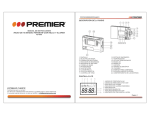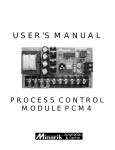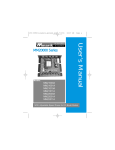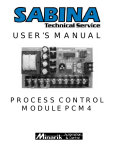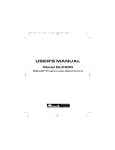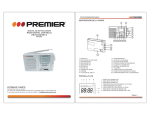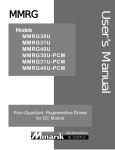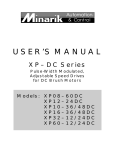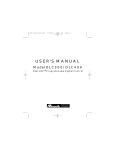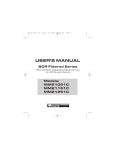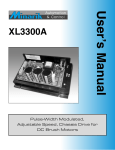Download USER`S MANUAL - Minarik Drives
Transcript
USER’S MANUAL PROCESS CONTROL MODULE PCM3 Copyright 2002 by Minarik Corporation All rights reserved. No part of this manual may be reproduced or transmitted in any form without written permission from Minarik Corporation. The information and technical data in this manual are subject to change without notice. Minarik Corporation and its Divisions make no warranty of any kind with respect to this material, including, but not limited to, the implied warranties of its merchantability and fitness for a given purpose. Minarik Corporation and its Divisions assume no responsibility for any errors that may appear in this manual and make no commitment to update or to keep current the information in this manual. MVD061402 Printed in the United States of America. i Safety Warnings SHOCK HAZARD AVOID HEAT KEE DR OID ATION • This symbol denotes an important safety tip or warning. PLEASE READ THESE INSTRUCTIONS CAREFULLY before performing any of the procedures contained in this manual. • DO NOT INSTALL, REMOVE, OR REWIRE THIS EQUIPMENT WITH POWER APPLIED. Have a qualified electrical maintenance technician install, adjust, and service this equipment. Follow the National Electrical Code (NEC) and all other applicable electrical and safety codes, including the provisions of the Occupational Safety and Health Act (OSHA) when installing equipment. • Reduce the chance of an electrical fire, shock, or explosion by proper grounding, over current protection, thermal protection, and enclosure. Follow sound maintenance procedures. Although this process control module isolates a voltage or current signal, its internal circuit potentials are at 115 VAC or 230 VAC above earth ground. Avoid direct contact with the printed circuit board or with circuit elements to prevent the risk of serious injury or fatality. Use a non-metallic screwdriver for adjusting the calibration trimpots. ii Contents Safety Warnings i Specifications 1 Dimensions 2 Introduction 3 Installation 4 Mounting . . . . . . . . . . . . . . . . . . . . . . . . . . . . . . . . . . . . . . . . . . .4 Wiring . . . . . . . . . . . . . . . . . . . . . . . . . . . . . . . . . . . . . . . . . . . . .5 Shielding guidelines . . . . . . . . . . . . . . . . . . . . . . . . . . . . . . . . . . .6 Screw terminal block . . . . . . . . . . . . . . . . . . . . . . . . . . . . . . . . . .7 AC line connections . . . . . . . . . . . . . . . . . . . . . . . . . . . . . . . . . .8 Voltage follower connection . . . . . . . . . . . . . . . . . . . . . . . . . . . .10 Current follower connection . . . . . . . . . . . . . . . . . . . . . . . . . . . .11 Leader signal generator connections . . . . . . . . . . . . . . . . . . . . .12 Output Voltage Connections . . . . . . . . . . . . . . . . . . . . . . . . . . . .14 Armature Voltage Follower . . . . . . . . . . . . . . . . . . . . . . . . . . . .16 Multiple Follower Motors . . . . . . . . . . . . . . . . . . . . . . . . . . . . . .18 Voltage/Current Selector Slide Switch . . . . . . . . . . . . . . . . . . . .20 Calibration 21 Voltage Signal Follower Calibration . . . . . . . . . . . . . . . . . . . . . .22 Manual Leader Control . . . . . . . . . . . . . . . . . . . . . . . . . . . . . . .23 Current Signal Follower . . . . . . . . . . . . . . . . . . . . . . . . . . . . . . .24 1-5 mA DC current signal input range: . . . . . . . . . . . . . . . . . . . . . . . .24 4-20 mA DC current signal input range: . . . . . . . . . . . . . . . . . . . . . . .25 10-50 mA DC current signal input range: . . . . . . . . . . . . . . . . . . . . . .26 iii Troubleshooting Certificate of Compliance Unconditional Warranty 28 31 inside back cover iv Illustrations Figure 1. Process Control Module Dimensions . . . . . . . . . . . . . . . . . .2 Figure 2. Screw Terminal Block . . . . . . . . . . . . . . . . . . . . . . . . . . . . . .7 Figure 3. 115VAC Power Connection . . . . . . . . . . . . . . . . . . . . . . . . .8 Figure 4. 230VAC Power Connection . . . . . . . . . . . . . . . . . . . . . . . . .9 Figure 5. Connection – Following an External Voltage Signal . . . . . . .10 Figure 6. Connection – Following an External Current Signal . . . . . . .11 Figure 7. Connection – Unidirectional Manual Leader Signal Source .13 Figure 8. Connection – Output Voltage . . . . . . . . . . . . . . . . . . . . . . . .15 Figure 9. Armature Voltage Follower Connections . . . . . . . . . . . . . . .17 Figure 10. Multiple Follower Motors Connection . . . . . . . . . . . . . . . .19 Figure 11. Voltage/Current Selectro Slide Switch . . . . . . . . . . . . . . . .20 Figure 12. Calibration Trimpot Layout . . . . . . . . . . . . . . . . . . . . . . . .21 Figure 13. Shunt Resistor Installation . . . . . . . . . . . . . . . . . . . . . . . .27 1 Specifications Power Requirements Line input 115VAC/230 VAC, 50/60 Hz, single phase Input Signal Ranges (input circuit is isolated) Voltage signal, narrow range 0 to +25 VDC Voltage signal, mid range 0 to +120 VDC Voltage signal, wide range 0 to +550 VDC Current signal 1–5 mADC, 4–20 mADC, 10–50 mADC Input Impedance Voltage signal Current signal, 1–5 mADC Current signal, 4–20 mADC Current signal, 10–50 mADC Output Impedance Voltage range, max Linearity Operating Temperature Range >25K 1K 235 100 ohms ohms ohms ohms 800 ohms 0 to +10 VDC 0.1% 0 – 50 °C 2 Dimensions 4.825 [123] 4.225 [107] IC1 C1 C2 OC1 MINARIK ELECTRIC T1 SIGNAL ISOLATOR R1 C3 R2 MAXIMUM OUTPUT R3 TP C4 2.700 [69] CURRENT IC2 P1 C5 P2 2.150 [55] P3 REF OUT MINIMUM OUTPUT TB1 1 2 3 4 5 6 7 8 9 10 1.280 [33] MOUNTING HOLE (4 EA) 0.146 [4] DIAMETER 0.250 [6] ALL DIMENSIONS IN INCHES [MILLIMETERS] Figure 1. Process Control Module Dimensions 3 Introduction Minarik model PCM3 signal isolators produce a floating DC voltage signal proportional to a variable DC current or voltage signal input. It also can generate the floating DC voltage signal output controlled by an external potentiometer. The output signal fed to a speed controller allows a motor to be driven automatically at a speed proportional to the signal, i.e., to follow the signal. The maximum PCM3 output voltage is 10 VDC. The PCM3 DC voltage output must be trimmed to not exceed the reference voltage, i.e., the normal voltage drop across the speed adjust potentiometer of the motor speed controller. For Minarik MM20000 series controls, the reference voltage is approximately 3.5 VDC. Putting higher DC voltage into the control speed adjust circuit will not produce correspondingly higher motor speeds. Such an error can seriously degrade the linearity between the process signal level and motor speed. This manual contains specifications, installation procedures, connections, and calibration procedures for the process control module, model PCM3. Refer to your variable speed drive user’s manual for additional installation, operation, and troubleshooting procedures. 4 Installation Mounting Warning Do not install, rewire, or remove this control with input power applied. Doing so may cause fire or serious injury. Make sure you read and understand the Safety Warnings on page i before attempting installation. • PCM3 components are sensitive to electrostatic fields. Avoid contact with the circuit board directly. • Protect the PCM3 from dirt, moisture, and accidental contact. • Provide sufficient room for access to the terminal block. • Mount the PCM3 away from other heat sources. Operate within the specified ambient operating temperature range. The operating temperature range for the PCM3 is 0°C through 50°C. • Prevent loose connections by avoiding excessive vibration of the process control module board. • Mount the PCM3 in either a horizontal or vertical plane. The PCM3 is mounted using 4 ea. 0.25 inch [6mm] standoffs. See Figure 1, page 2 for the physical locations of these standoffs. Use #8 panhead screws to fasten the standoffs to the mounting surface. Installation Wiring Warning 쇵 Do not install, rewire, or remove this control with input power applied. Failure to heed this warning may result in fire, explosion, or serious injury. This drive is isolated from earth ground. Circuit potentials are at 115 or 230 VAC above ground. To prevent the risk of injury or fatalisty, avoid direct contact with the printed circuit board or with circuit elements. Do not disconnect any of the motor leads from the drive unless power is removed or the drive is disabled. Opening any one motor lead may destroy the drive. • Use 18-24 AWG wire for speed adjust potentiometer wiring. Use 14–16 AWG wire for AC line (L1, L2) and motor (A1 and A2) wiring. 5 6 Installation Shielding guidelines Warning Under no circumstances should power and logic leads be bundled together. Induced voltage can cause unpredictable behavior in any electronic device, including motor controls. As a general rule, Minarik recommends shielding of all conductors. If it is not practical to shield power conductors, Minarik recommends shielding all logic-level leads. If shielding is not practical, the user should twist all logic leads with themselves to minimize induced noise. It may be necessary to earth ground the shielded cable. If noise is produced by devices other than the PCM module, ground the shield at the module end. If noise is generated by a device on the PCM module, ground the shield at the end away from the PCM module. Do not ground both ends of the shield. If the module continues to pick up noise after grounding the shield, it may be necessary to add AC line filtering devices, or to mount the PCM module in a less noisy environment. Logic wires from other input devices, such as motion controllers and PLL velocity controllers, must be separated from power lines in the same manner as the logic I/O on this drive. Installation 7 Screw terminal block Connections to Minarik’s PCM3 are made to a screw terminal block. Using a screwdriver, turn the terminal block screw counterclockwise to open the wire clamp. Insert stripped wire into the wire clamp. Turn the terminal block screw clockwise to clamp the wire. See Figure 2. Figure 2. Screw Terminal Block 8 Installation AC line connections Connect AC power leads to terminals 1 and 4. When operating on 115VAC, leave the jumper bars installed between terminals 1 and 2 and between 3 and 4 (see Figure 3). This is the PCM3’s default (factory) setting. When operating on 230VAC, remove both jumper bars and place one jumper bar between terminals 2 and 3 (see Figure 4, page 9). IC1 C1 C2 OC1 MINARIK ELECTRIC T1 SIGNAL ISOLATOR R1 C3 R2 MAXIMUM OUTPUT R3 TP C4 CURRENT IC2 P1 C5 P2 P3 MINIMUM OUTPUT TB1 5 1 6 7 8 4 AC POWER 115 VAC INPUT JUMPER BARS INSTALLED BETWEEN TERMINALS 1 & 2 AND TERMINALS 3 & 4 Figure 3. 115VAC Power Connection 9 10 9 Installation IC1 C1 C2 OC1 MINARIK ELECTRIC T1 SIGNAL ISOLATOR R1 C3 R2 MAXIMUM OUTPUT R3 TP C4 CURRENT IC2 P1 C5 P2 P3 MINIMUM OUTPUT TB1 5 1 6 7 8 4 AC POWER 230 VAC INPUT JUMPER BAR INSTALLED BETWEEN TERMINALS 2 & 3 Figure 4. 230VAC Power Connection 9 10 10 Installation Voltage follower connection (1) Set the Current/Voltage Switch to Voltage. (2) Connect the incoming voltage signal leads as shown in Figure 5 below. (3) Connect the negative lead to Terminal 5. (4) If the voltage signal is less than 20VDC, connect the positive lead to Terminal 6. If the voltage signal is less than 120VDC, connect the positive lead to Terminal 7. If the voltage signal is greater than 120VDC, connect the positive lead to Terminal 8. R1 R2 MAXIMUM OUTPUT R3 TP CURRENT P1 INPUT P2 P3 VOLTAGE MINIMUM OUTPUT 1 2 3 4 5 0 - 20 VDC VOLTAGE SIGNAL 6 7 8 9 CURRENT/ VOLTAGE SWITCH REF (+) 0 - 120 VDC VOLTAGE SIGNAL 10 REF (+) 0 - 550 VDC VOLTAGE SIGNAL COM (-) REF (+) Figure 5. Connection – Following an External Voltage Signal Installation 11 Current follower connection (1) Set the Current/Voltage Switch to Current. (2) Connect the incoming current signal leads as shown in Figure 6 below. (3) Connect the negative lead to Terminal 5. (4) Connect the positive lead to Terminal 6. R1 R2 MAXIMUM OUTPUT R3 TP CURRENT P1 INPUT P2 P3 VOLTAGE MINIMUM OUTPUT 1 2 3 4 5 6 COM (-) REF (+) 7 8 9 10 CURRENT/ VOLTAGE SWITCH CURRENT FOLLOWER INPUT Figure 6. Connection – Following an External Current Signal 12 Installation Leader signal generator connections The PCM3 can be used as a leader controller in one of two ways. It can provide a floating DC leader voltage input to other PCM3 modules interfacing with standard variable speed drives.It can also drive several variable speed drives directly, provided that their circuit design permits wiring of their speed circuits in common. Unidirectional applications require a positive PCM3 output. Connect a 10K ohm potentiometer (not provided with the PCM3) as the leader control pot using the +10 VDC REF OUT supply on the PCM3. Refer to Figure 7 (page 13). To connect an external leader control potentiometer, attach the CW side of the potentiometer to the REF OUT terminal. The potentiometer wiper is connected to terminal 6. The CCW terminal is connected to terminal 5. Installation 13 IC1 C1 C2 OC1 MINARIK ELECTRIC T1 SIGNAL ISOLATOR R1 C3 R2 MAXIMUM OUTPUT R3 TP C4 CURRENT IC2 P1 C5 REF OUT P2 INPUT P3 VOLTAGE MINIMUM OUTPUT TB1 1 2 3 4 5 6 7 8 9 10 CW 10K OHM SPEED ADJUST POTENTIOMETER Figure 7. Connection – Unidirectional Manual Leader Signal Source 14 Installation Output Voltage Connections Warning Always check the instruction manual supplied with the variable speed drive that will be interfaced with the PCM3 module. The scheme shown for wiring to an external voltage source, as well as the specifications on that input, must be well understood before proceeding. Most Minarik controls have positive reference voltage across the speed adjust pot with respect to the CCW side. The pot wiper position determines the fraction of this control reference voltage that will be applied to the speed adjustment circuit. In these controls, the application of a positive voltage at the wiper with reference to the CCW connection will cause the motor to run. Output connections are made to terminals 9 and 10 of terminal board TB501. Connect the negative lead to terminal 9. Connect the positive lead to terminal 10. Refer to Figure 8 (page 15). Some controls have a negative reference voltage across the speed adjust pot. Reverse the polarity of the connection to such controls. Installation R1 R2 MAXIMUM OUTPUT R3 TP CURRENT P1 P2 P3 MINIMUM OUTPUT 2 3 4 5 6 7 8 9 10 COM (-) REF (+) 0 - 10 VDC OUTPUT Figure 8. Connection – Output Voltage 15 16 Installation Armature Voltage Follower The PCM3 may be used as an interface to control one motor speed in proportion to that of an independent DC motor. The input signal would be taken from the voltage across the armature of the 'leader' motor, since speed is proportional to this voltage. To follow the armature voltage signal, wire the positive side of the armature voltage to Terminal 7 (if 0-120 VDC range) or to Terminal 8 (if 0550 VDC range). Wire the negative side of the armature voltage to Terminal 5 as shown in Figure 9 (page 17). Connect Terminals 9 and 10 to the speed control circuit in the follower controller, according to the instructions provided with the speed controller. With most Minarik controls, connect Terminal 9 of the PCM3 to the terminal for the CCW end of the control speed pot and Terminal 10 of the PCM3 to the wiper terminal. The pot wiper should be left disconnected from the control so that only the PCM3 output will control the motor speed. Remember that the connections of Terminals 9 and 10 must be reversed if the Minarik control has a negative reference voltage. Installation IC1 C1 C2 OC1 MINARIK ELECTRIC T1 SIGNAL ISOLATOR R1 C3 R2 MAXIMUM OUTPUT R3 TP C4 CURRENT IC2 P1 C5 REF OUT INPUT P2 P3 VOLTAGE MINIMUM OUTPUT TB1 1 2 3 4 5 6 7 8 9 10 MOTOR A2 S3 A1 S2 S1 S1 10K OHM SPEED ADJUST POTENTIOMETER S2 A1 S3 A2 CW MOTOR MM20000 SERIES DRIVE (LEADER) MM20000 SERIES DRIVE (FOLLOWER) Figure 9. Armature Voltage Follower Connections 17 18 Installation Multiple Follower Motors If more than one 'follower' motor speed controller is to follow the output from a single 'leader' PCM3, setting the ratio between two or more of the motor speeds can be accomplished with ratioing pots (Figure 10, page 19). Wire Terminal 10 of the PCM3 to the CW end of the pot. Disconnect that side of the speed pot from its terminal on the follower control. Wire the pot wiper to the speed adjust wiper terminal. Wire the CCW side of the pot and the output from PCM3 Terminal 9 to the speed adjust CCW terminal on the control. Installation 19 IC1 C1 C2 OC1 MINARIK ELECTRIC T1 SIGNAL ISOLATOR R1 C3 R2 MAXIMUM OUTPUT R3 TP C4 CURRENT IC2 P1 C5 REF OUT P2 INPUT P3 VOLTAGE MINIMUM OUTPUT TB1 1 2 3 4 5 6 7 8 9 10 10K OHM MASTER SPEED ADJUST POTENTIOMETER INH2 CW S3 S2 MM20000 SERIES FOLLOWER #1 10K OHM SPEED ADJUST POTENTIOMETER S1 CW A1 A2 MOTOR #1 INH2 S3 S2 MM20000 SERIES FOLLOWER #2 10K OHM SPEED ADJUST POTENTIOMETER S1 CW A1 A2 MOTOR #2 Figure 10. Multiple Follower Motors Connection 20 Installation Voltage/Current Selector Slide Switch See Figure 11 for the Voltage/Current Selector Slide Switch. Set the swtich to VOLTAGE for voltage input mode, otherwise, set it to CURRENT for current input mode. VOLTAGE/CURRENT SELECTOR SLIDE SWITCH IC1 C1 C2 OC1 MINARIK ELECTRIC T1 SIGNAL ISOLATOR R1 C3 R2 MAXIMUM OUTPUT R3 TP C4 CURRENT IC2 P1 C5 P2 P3 MINIMUM OUTPUT TB1 1 2 3 4 5 6 7 8 9 10 Figure 11. Voltage/Current Selectro Slide Switch 21 Calibration Warning Dangerous voltages exist on the drive when it is powered and up to 30 seconds after power is removed and the motor stops. BE ALERT. High voltages can cause serious or fatal injury. For your safety, use personal protective equipment (PPE) when operating this drive. All adjustments increase with CW rotation, and decrease with CCW rotation. Use a non-metallic screwdriver for calibration. Each trimpot is identified on the printed circuit board. Refer to Figure 12 for trimpot layout. INPUT IC1 C1 C2 OC1 MINARIK K ELECTRIC RI T1 SIGNAL ISOLATOR R1 C3 R2 MAXIMUM OUTPUT R3 MAXIMUM OUTPUT TP C4 CURRENT IC2 P1 C5 P2 MINIMUM OUTPUT P3 MINIMUM OUTPUT TB1 1 2 3 4 5 6 7 8 9 10 Figure 12. Calibration Trimpot Layout 22 Calibration Voltage Signal Follower Calibration Set the VOLTAGE/CURRENT selector switch to VOLTAGE. Confirm that the positive DC voltage input lead is connected to the appropriate terminal. (1) Apply the maximum DC voltage input signal. (2) Adjust the INPUT trimpot until the voltage measured between the Test Point (post on board, marked TP) and Terminal 5 is approximately one-half of the Reference Voltage of the speed control. (3) Adjust MAXIMUM OUTPUT trimpot to achieve the desired maximum output voltage across Terminals 9 and 10, which normally is equal to or less than the control Reference Voltage, depending upon whether the motor is to run at its rated speed or at a slower speed with maximum DC input voltage to the PCM3. (4) Apply the minimum DC voltage input signal. (5) Adjust MINIMUM OUTPUT trimpot to achieve the desired minimum output voltage across Terminals 9 and 10 or, alternatively, to achieve the desired minimum speed of the motor. Calibration 23 Manual Leader Control Set the VOLTAGE/CURRENT selector switch to VOLTAGE. Confirm that a 10K ohm leader speed adjust potentiometer has been properly wired between REF OUT (CW) and Terminal 5 (CCW), with its wiper wired to Terminal 6. (1) Set the leader speed adjust potentiometer to maximum (full CW). (2) Adjust INPUT trimpot until voltage measured between the Test Point (post on board, marked TP) and Terminal 5 is approximately one-half of the reference voltage of the speed control. (3) Adjust MAXIMUM OUTPUT trimpot to achieve the desired maximum output voltage across Terminals 9 and 10. This voltage is equal to or less than the control reference voltage, depending upon the desired motor speed. (4) Rotate the leader potentiometer wiper fully CCW. (5) Adjust MINIMUM OUTPUT trimpot to achieve the desired minimum output voltage across Terminals 9 and 10 or, alternatively, to achieve the desired minimum speed of the motor. 24 Calibration Current Signal Follower Set the VOLTAGE/CURRENT selector slide switch to CURRENT. 1-5 mA DC current signal input range: (1) Apply a 5 maDC signal across Terminals 5 and 6. (2) Adjust INPUT trimpot until voltage measured between the Test Point (post on board, marked TP) and Terminal 5 is approximately one-half of the Reference Voltage of the speed control. (3) Adjust MAXIMUM OUTPUT trimpot to achieve the desired maximum output voltage across Terminals 9 and 10, which normally is equal to or less than the control Reference Voltage, depending upon whether the motor is to run at its rated speed or at a slower speed with maximum DC input current to the PCM3. (4) Apply a 1 mADC signal across Terminals 5 and 6. (5) Adjust MINIMUM OUTPUT trimpot to achieve the desired minimum output voltage across Terminals 9 and 10 or, alternatively, to achieve the desired minimum speed of the motor. (6) Repeat Steps 1 through 5 once. Calibration 25 4-20 mA DC current signal input range: (1) Apply a 20 mADC signal across Terminals 5 and 6. (2) Adjust MAXIMUM OUTPUT trimpot to achieve the desired maximum output voltage across Terminals 9 and 10, which normally is equal to or less than the control Reference Voltage, depending upon whether the motor is to run at its rated speed or at a slower speed with maximum DC input current to the PCM3. (3) Apply a 4 mADC signal across Terminals 5 and 6. (4) Adjust MINIMUM OUTPUT trimpot to achieve the desired minimum output voltage across Terminals 9 and 10 or, alternatively, to achieve the desired minimum speed of the motor. (5) Repeat Steps 1 through 4 once. 26 Calibration 10-50 mA DC current signal input range: Shunt a 1K ohm, 3W resistor across Terminals 5 and 6 as shown in Figure 13 (page 27). (1) Apply a 50 mADC signal across Terminals 5 and 6. (2) Adjust MAXIMUM OUTPUT trimpot to achieve the desired maximum output voltage across Terminals 9 and 10, which normally is equal to or less than the control Reference Voltage, depending upon whether the motor is to run at its rated speed or at a slower speed with maximum DC input current to the PCM3. (3) Apply a 10 mA DC signal across Terminals 5 and 6. (4) Adjust MINIMUM OUTPUT trim pot to achieve the desired minimum output voltage across Terminals 9 and 10 or, alternatively, to achieve the desired minimum speed of the motor. (5) Repeat Steps 1 through 4 once. Calibration IC1 C1 C2 OC1 MINARIK ELECTRIC T1 SIGNAL ISOLATOR R1 C3 R2 MAXIMUM OUTPUT R3 TP C4 CURRENT IC2 P1 C5 P2 P3 MINIMUM OUTPUT TB1 1 2 3 4 5 6 7 8 9 SHUNT RESISTOR Figure 13. Shunt Resistor Installation 10 27 28 Troubleshooting Warning Dangerous voltages exist on the PCM3 when it is powered. When possible, disconnect PCM3 and drive while troubleshooting. High voltages can cause serious or fatal injury. Before troubleshooting Perform the following steps before starting any procedure in this section: • Disconnect AC line voltage from the PCM3 and variable speed drive. • Check the PCM3 and drive closely for damaged components. • Check that no conductive or other foreign material has become lodged on the printed circuit board. • Verify that every connection is correct and in good condition. • Verify that there are no short circuits or grounded connections. • Check that the input voltage jumpers are installed properly for the input voltage being used (see page 8). • Check that the drive’s rated armature and field outputs are consistent with the motor ratings. For additional assistance, contact your local Minarik distributor, or the factory direct: 1-800-MINARIK (646-2745) or Fax: 1-800-394-6334 Troubleshooting 29 Problem Possible Causes Suggested Solutions End user’s drive does not respond to encoder signal 1. No output voltage from PCM3 (TB1). 1. Recalibrate the PCM3. If there is still no output send PCM3 to Minarik for repair. 2. Loose connections between PCM3 and motor drive. 2. Check connections between TB1 and the input of motor drive. 3. PCM3 is not receiving AC line voltage. 3. Apply AC line voltage to terminals 1and 4. 4. Input signal is not connected. 4. Check that the PCM3 is receiving voltage (or current) input signal. 5. INPUT pot is not calibrated. 5. Calibrate INPUT pot (page 24). 6. Motor drive not calibrated properly. 6. Re-calibrate motor drive according to manufacturer’s instructions. 30 Troubleshooting Problem Possible Causes Suggested Solutions 1. Voltage out (TB1) is End user’s motor not changing as drive does not reach input changes full speed 1. Check that the voltage out (TB1) is changing as input changes. Recalibrate the PCM3. IF voltage is still not changing send the drive to Minarik repair. 2. Loose connections between PCM3 and motor drive. 2. Check connections between TB1 and the input of motor drive. 1. Motor drive not calibrated properly. 1. Re-calibrate motor drive according to manufacturer’s instructions. End user’s motor does not respond properly (runs too slow, or too fast) to PCM3 31 Certificate of Compliance Minarik Corporation hereby certifies that PCM3 Signal Isolator has been approved to bear the “CE” mark. The PCM3 has been tested to the following test specifications: EN55011:1991 (emissions), and EN50082-1:1992 (immunity) Compliance allows the PCM3 to bear the CE mark. The end user, as described herein, falls into one of two categories: 1. The Consumer will deploy a stand-alone unit as an integral, yet external, portion of the machine he/she is operating. 2. The Original Equipment Manufacturer (OEM) will implement the product as a component of the machine being manufactured. 32 Certificate of Compliance CE is a machinery directive. Whether or not every component in the OEM’s machinery meets CE, the OEM must still submit its machine for CE approval. Thus, no component must necessarily meet CE within the machine, as long as the OEM takes the necessary steps to guarantee the machine does meet CE. By the same token, even if every component in the OEM’s machine does meet CE, the machine will not necessarily meet CE as a machine. Using CE-approved wiring and filtering practices guarantee the controller will meet EN55011 (1991 emissions standard) and EN50082-1 (1992 immunity standard). Notes Notes Unconditional Warranty A. Warranty - Minarik Corporation (referred to as “the Corporation”) warrants that its products will be free from defects in workmanship and material for two (2) years or 6,000 hours, whichever comes first, from date of shipment thereof. Within this warranty period, the Corporation will repair or replace such products that are: (1) returned to Minarik Corporation, 901 East Thompson Avenue, Glendale, CA 912012011 USA; and, (2) determined by the Corporation to be defective. This warranty shall not apply to any product that has been subject to misuse, negligence, or accident; or misapplied; or repaired by unauthorized persons; or improperly installed. The Corporation is not responsible for removal, installation, or any other incidental expenses incurred in shipping the product to and from the repair point. B. Disclaimer - The provisions of Paragraph A are the Corporation’s sole obligation and exclude all other warranties of merchantability for use, express or implied. The Corporation further disclaims any responsibility whatsoever to the customer or to any other person for injury to the person or damage or loss of property of value caused by any product that has been subject to misuse, negligence, or accident, or misapplied or modified by unauthorized persons or improperly installed. C. Limitations of Liability - In the event of any claim for breech of any of the Corporation’s obligations, whether express or implied, and particularly of any other claim or breech of warranty contained in Paragraph A, or of any other warranties, express or implied, or claim of liability that might, despite Paragraph B, be decided against the Corporation by lawful authority, the Corporation shall under no circumstances be liable for any consequential damages, losses, or expense arising in connection with the use of, or inability to use, the Corporation’s product for any purpose whatsoever. An adjustment made under warranty does not void the warranty, nor does it imply an extension of the original two (2) year or 6,000 hour warranty period. Products serviced and/or parts replaced on a no-charge basis during the warranty period carry the unexpired portion of the original warranty only. If for any reason any of the foregoing provisions shall be ineffective, the Corporation’s liability for damages arising out of its manufacture or sale of equipment, or use thereof, whether such liability is based on warranty, contract, negligence, strict liability in tort, or otherwise, shall not in any event exceed the full purchase price of such equipment. Any action against the Corporation based upon any liability or obligation arising hereunder or under any law applicable to the sale of equipment or the use thereof, must be commenced within one year after the cause of such action arises. 901 East Thompson Avenue Glendale, California 91201-2011 Tel.: 1-800-MINARIK (646-2745) Fax: 1-800-394-6334 www.minarikcorp.com Document Number 250-0082, Revision 4 Printed in the U.S.A – 6/02











































